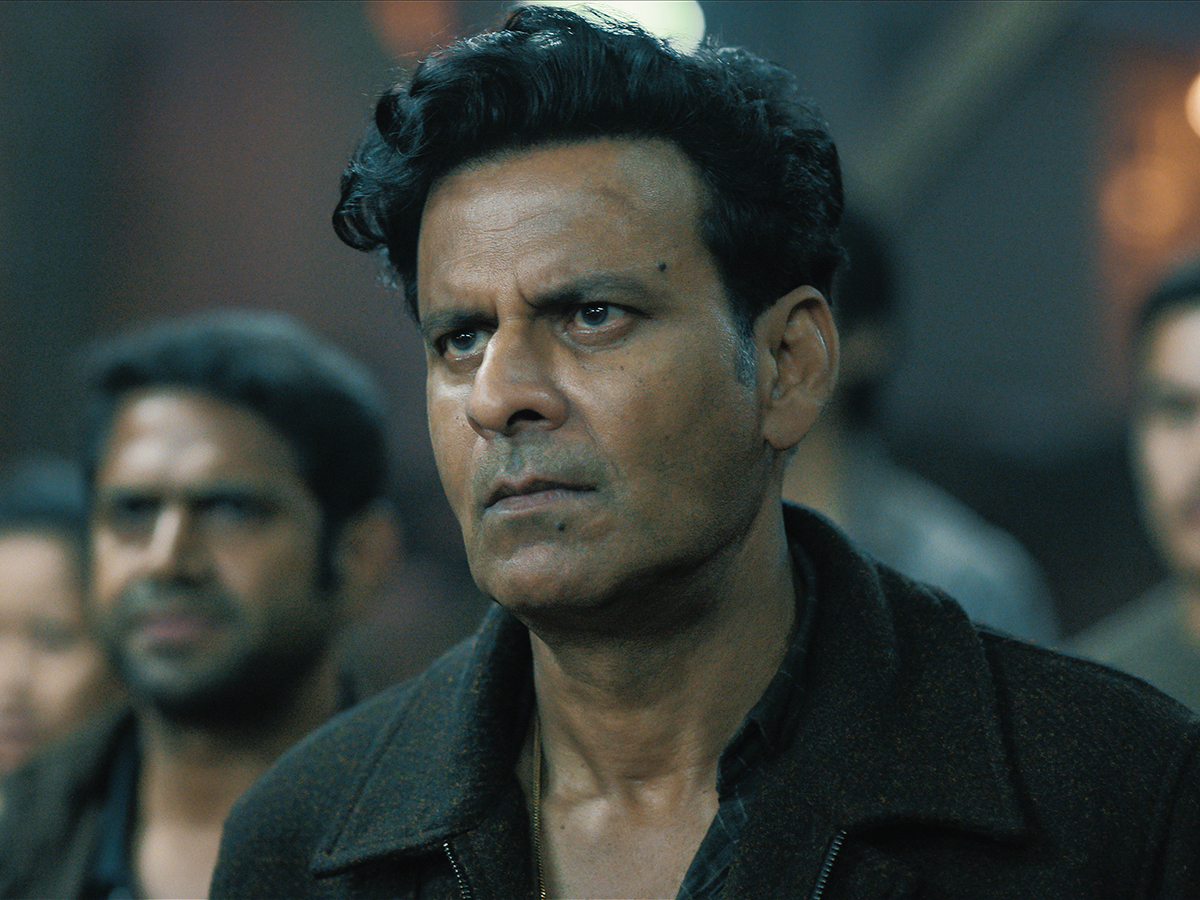The Family Man Season 3, now streaming on Prime Video, brings back the Everyman-turned-operative Shrikant Tiwari for another covert assignment. This time plunging into the dense, uneasy terrain of Nagaland. The show retains its familiar pleasures: sleek action set pieces, deadpan humor, sharply drawn supporting characters, and plot turns engineered for maximum engagement. Yet as the season moves from one episode to the next, a faint sense of formula begins to surface, as if the series were checking off its own well-established narrative moves rather than discovering new ones.
A series of explosions ripples across the Northeast, unsettling Prime Minister Basu’s (Seema Biswas) assurances of calm and pulling Srikant Tiwari (Manoj Bajpayee) back into a world he keeps trying to outgrow. Even as he and Suchitra (Priyamani) settle into a new apartment financed through her work at a Chinese-backed wellness app, the country’s political fault lines begin to tilt. In Nagaland, Srikant and Kulkarni seek the support of David Khuzou (Sunil Thapa), a veteran attempting to coax disparate insurgent groups toward compromise. The effort collapses when David’s grandson rejects the talks, and an orchestrated assault, engineered by the smuggler Rukhma (Jaideep Ahlawat) under the contract of Meera Eston (Nimrat Kaur) and her offshore patrons, leaves David dead and Srikant wounded. What follows is a pursuit shaped as much by misinformation as by gunfire. As Srikant’s family becomes collateral in a coordinated smear campaign and the state edges toward war, he moves through a landscape thick with hidden agendas, closing in on a confrontation that promises no clean victories.
In recent years, the Northeast has emerged as an unexpected focal point for Indian streaming platforms, drawn perhaps by its layered histories, uneasy borders, and long-neglected political tensions. The Family Man Season 3 joins this growing list, with the director team of Raj and D.K., alongside Tusshar Syed and Suman Kumar, shaping the season into a fast-paced geopolitical thriller. The show tackles a combustible set of anxieties. China’s covert construction of “phoenix villages” along the border, their use as training zones for insurgent groups, and the global arms networks that profit handsomely from instability in the region. What’s most striking, though, is the inversion at the heart of this chapter. The stalwart operative becomes the quarry. Shrikant Tiwari, once the agency’s most reliable foot soldier, finds himself pursued by the very organization, TASC, that once relied on his instincts. The season also glances toward the complexities of New Delhi’s attempts to broker peace in the Northeast, where every negotiation is met with resistance from entrenched militant factions and centuries-old grievances. Yet the series resists sliding into sermonizing. Instead, it embeds these political tremors within a tightly engineered narrative, keeping the viewer tethered to the human stakes even as the geopolitical canvas expands.
As in the earlier seasons, the new antagonists shape the narrative’s architecture, and this time the series presents two formidable adversaries who could not be more different from each other. On one side is Rukma, a ruthless trafficker operating in the borderlands of Nagaland, someone shaped by the brutal economies of the region, where the state’s absence has long been filled by illicit trade. On the other is Meera Eston, a British national of Indian descent, whose corporate polish and strategic brilliance make her an altogether different kind of threat. Working from London as a high-level fixer for global conglomerates, she collaborates with billionaire Dwarkanath (Jugal Hansraj) and a consortium of defense contractors known as The Collective, hinting at the porous boundaries between international capital, private warfare, and state policy. The gulf between their social positions, Meera’s cosmopolitan access versus Rukma’s survivalist world, shows how violence is distributed along lines of class, geography, and opportunity. Their pairing becomes one of the season’s most intriguing contrasts. Yet the show suggests that both are ultimately instruments of a much larger machine. Meanwhile, Zoya returns to TASC, now driven by a sense of vengeance for Milind’s death. Her arc adds another layer of tension within the agency itself, complicating loyalties just as the narrative spans multiple regions and exposes the ways national politics are both shaped and destabilized by forces at the periphery.

The series has always invested in the personal lives of its characters, and this season continues that thread with more maturity. Dhriti and Atharv have grown up, and the writing captures their shifting perspectives as teenagers on the cusp of entering the adult world. Srikant and Suchitra’s marriage is inching toward divorce, yet there remains a quiet, lingering care between them. Rukhma, after losing his girlfriend, is now saddled with the responsibility of raising the child born out of their relationship. This subplot reveals the unexpectedly vulnerable, human layer of a character otherwise shaped by ruthlessness. JK, meanwhile, registers on a matrimonial site and begins the awkward, hopeful search for a suitable partner. Together, these narrative strands deepen the emotional ecosystem of the show. They remind us that beneath the intelligence operations and national crises are individuals navigating grief, desire, and the everyday challenges of being human.
Yet beneath the season’s earnest ambitions, a familiar structural pattern begins to reveal itself. Certain stylistic signatures, particularly the extended, single-take action sequences that once felt fresh, no longer carry the same charge. They appear more like obligations to an established formula than organic outgrowths of the story. Some character arcs contribute to this sense of repetition. Major Sameer, reintroduced with the air of a returning nemesis, drifts through the plot without clear purpose, his presence feeling more necessary to franchise continuity than to this season’s internal logic. Likewise, the network of informers and double agents embedded in various government departments becomes increasingly predictable, reducing the suspense the show once handled with greater finesse. Even the larger plot threads, an assassination attempt on the prime minister, an off-the-books military operation, and the recurring motif of high-stakes peace talks in Nagaland, echo tropes that other series have explored with far greater urgency and surprise. Here, they start to feel overworked, as if the series were looping through familiar narrative coordinates rather than uncovering new dramatic terrain. The effect is even more noticeable in a field already dense with shows exploring similar themes.
In terms of performances, the series continues to operate on remarkably sure footing. Manoj Bajpayee once again anchors the narrative with a performance that is both tightly controlled and unexpectedly fragile. His Srikant Tiwari wears exhaustion like a second skin, yet still moves with the instinctive intelligence of a man who cannot quite abandon the fight. Sharib Hashmi’s JK remains the show’s warm counterpoint. His easy rapport with Bajpayee gives the season some of its most relaxed, quietly humorous moments. Jaideep Ahlawat brings a bruised gravitas to Rukma, crafting an antagonist who is terrifying not because he lacks feeling but because he guards what little remains. Nimrat Kaur’s Meera Eston is played with a cool, transactional clarity. She radiates a charm that makes her ruthlessness feel all the more unsettling. The wider ensemble—Priyamani, Gul Panag, Aditya Srivastava, Seema Biswas, Shreya Dhanwanthary, Vipin Sharma, Ashlesha Thakur, and Vedant Sinha, among others—fortifies the world with lived-in presence rather than mere narrative function.
Jay Charola’s cinematography captures the shifting geographies with a textured eye. The misted hills of Nagaland, the narrow bureaucratic corridors of Delhi, and the cramped intimacies of the Tiwari household are framed with a textured sensitivity that gives each space a vivid sense of lived texture. Sumeet Kotian’s editing lends the episodes a measured momentum, allowing us to inhabit the characters’ urgency without surrendering clarity. The sound design by Sanjay and Allwin deepens the world’s atmospherics, while Ketan Sodha’s background score threads through the narrative with a steady, unobtrusive pulse, heightening tension without overwhelming it.
The Family Man Season 3 may lean on familiar structures, but its performances, craftsmanship, and political ambition keep it compelling. Even when the narrative wavers, the show’s blend of urgency, humor, and human frailty ensures that its world remains worth returning to.





